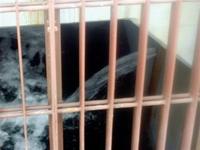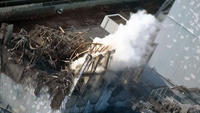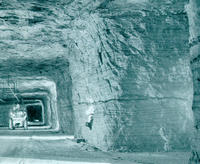-
Portable military barriers help Canadian city in flood fight
Canada is using a new technology to prevent flood damage in Manitoba; the one-meter-square wire cages can be unfolded and quickly filled with dirt or mud; they can also be linked for a long row that can be set up far quicker than it takes to sling sandbags; the barriers have been used by the U.S. military to protect embassies from terrorist attacks, and have also been used for flood protection in the United States
-
-
Huawei tries to crack U.S. market again with U.S. Cellular deal
Chinese giant Huawei Technologies Co. recently announced that it was the finalist for a contract to build a fourth generation wireless network for U.S. Cellular Corp, the nation’s sixth largest wireless carrier; in response to the deal, U.S. lawmakers sent a letter to President Obama to permanently stop Huawei’s efforts to sell network infrastructure in the United States; in the past, lawmakers have vocally opposed Huawei’s attempts to enter the U.S. market fearing that the telecom giant would install equipment that contains bugs that would make it easier for China to steal information, shut down communications, or make networks easier to hack; Huawei is the world’s second largest telecom manufacturer
-
-
Release of radioactive water into ocean stopped

Radioactive water stopped flowing from Japan’s damaged nuclear power plant into the Pacific Ocean Wednesday after a special material was used, the utility said; the release, which began Monday, was described as an unavoidable process to avert a much bigger problem resulting from the leakage of the highly contaminated water; in terms of volume, about three million gallons of low-level radioactive water will have been dumped into the seas; the flooded basement of the buildings and their underground trenches at Nos. 1, 2, and 3 reactors are believed to hold about 60,000 tons of the more highly radioactive water; this water, which is also preventing workers from doing other emergency work, eventually will be stored in tanks at the reactors’ nuclear waste disposal sites, the government nuclear safety agency said. Those tanks will be shipped by the end of this month, the agency said
-
-
Modeling shows limited spread of Fukushima's radioactive release in ocean
Daily computer simulations are suggesting that, so far, the hazardous radioactive materials being released into the sea by the Fukushima nuclear plants are still largely restricted to areas near the coast; the powerful Kuroshiro current — the Pacific’s version of the Gulf Stream — tends to block contaminated seawater from flowing southward toward Tokyo Bay while picking up little contamination itself
-
-
IAEA: after Japan, no more nuclear "business as usual"

The world cannot take a “business as usual” approach to nuclear power in the wake of the disaster in Japan, UN atomic watchdog chief Yukiya Amano said; “Thinking retrospectively, the measures taken by the operators as a safety measure (were) not sufficient to prevent this accident,” Amano said; he added that the crisis in Japan caused by the 11 March earthquake and tsunami “has enormous implications for nuclear power and confronts all of us with a major challenge”
-
-
Scientific explanation overturned -- good news for nuclear fusion
A team of Duke University researchers has discovered, much to its surprise, that a long-accepted explanation of how nuclei collide to produce charged particles for electricity — a process receiving intense interest lately from scientists, entrepreneurs, and policy makers in the wake of Japan’s nuclear crisis — is flat out wrong; the discovery of the error makes nuclear reactors based on fusion more realistic
-
-
Subterranean salt beds to keep U.S. nuclear waste

Beds of salt up to one kilometer thick lie within one or two kilometers of the surface across much of the United States; they were deposited hundreds of millions of years ago by evaporating seas; a new study suggests that since President Obama killed the only national nuclear waste burial program — the Yucca mountain site — the United States should look again at the pre-Yucca plan to bury nuclear waste in subterranean salt beds
-
-
Heavy snows divert Colorado River water shortage, for now

This winter, heavy snowfall in Utah, Colorado, and Wyoming have helped to avert a water crisis along the Colorado River; after an eleven year drought in the region, residents have begun to worry about impending water shortages; the Colorado River supplies nearly thirty million people in seven states with drinking water as well as Mexico; the heavy snows could bring only a brief moment of respite; with demand exceeding supplies and with each year bringing less water, there is potential for a future disaster; if supplies continue to decline, water deliveries will be reduced when Lake Mead’s water level drops below 1,075 feet; as of 1 February, Lake Mead’s water level was at 1,091feet
-
-
Sector Report for Monday, 4 April 2011: Infrastructure protection
This report contains the following stories.
Plus 2 additional stories
-
-
Recent major natural gas explosions could have been prevented
Last month, after a series of deadly accidents, the National Transportation Safety Board (NTSB) conducted hearings on the status of U.S. natural gas pipelines and found that utilities have long resisted implementing recommended safety measures leading to the increased likelihood of fatal explosions; the United States currently has more than 210 natural gas pipeline systems with roughly 21,000 miles of pipeline snaking throughout heavily populated areas; some of these pipes were first put in place more than eighty years ago; utilities could have minimized the damage caused by the recent explosions and even prevented the accidents from occurring had they installed safety valves, conducted regular testing, and replaced aging infrastructure
-
-
Protecting Japan from tsunamis
As Japan begins to rebuild after the massive 9.0 magnitude earthquake and tsunami, engineers are beginning to analyze the destruction to learn how to better prepare for future natural disasters; one expert says that prior to the earthquake, more infrastructures spending, particularly for projects aimed at preventing the approaching tsunami, could have mitigated much of the damage; the tsunami easily overwhelmed one of the tallest and longest seawalls in Japan; officials will have to decide whether to reinvest in costly tsunami infrastructure or to relocate communities further from the ocean to minimize the numbers affected by such events
-
-
Record number of infrastructure funds raising money, worst results in years
More private-equity infrastructure funds are seeking to raise money around the world than ever before, but with the increase in competition, funds are struggling to reach their funding goals; 131 unlisted infrastructure funds are seeking to raise a total of $92.1 billion; so far only two infrastructure funds reached their fundraising goals, raising a total of $600 million, the lowest amount in seven years; in the first quarter of 2010, seven funds met their goals raising a total of $7.5 billion dollars; infrastructure funds will likely become more popular as inflation rises but analysts expect funds to raise less money than in previous years
-
-
Water infrastructure budgets to see massive cuts in 2012
Next year water infrastructure projects and programs are expected to see massive budget cuts as President Obama has proposed slashing infrastructure spending at the Environmental Protection Agency (EPA) and the U.S. Army Corps of Engineers; the Drinking Water State Revolving Fund (SRF) will see nearly $400 million cuts and the Clean Water SRF will be cut nearly $600 million; according to Lisa Jackson, the EPA administrator, these cuts in SRF budgets reflect a return to a more “sustainable level”; states worry that cuts will make it difficult to fund future infrastructure upgrades; reports have shown that the United States faces a $500 billion shortfall for water infrastructure funding over the next twenty years
-
-
Report finds thousands of U.S. bridges in dangerous need of repair
Last week a new report found that nearly 12 percent of the bridges in the United States were “structurally deficient” and required replacement; the report found that major repairs and critical maintenance has often been delayed as states are struggling with budget shortfalls; the average age of bridges across the country is nearing forty-two years, and most were designed to have a fifty year lifespan before they were replaced or reconstructed; Transportation for America has called for increased federal funding for infrastructure to help make repairs; the American Society of Civil Engineers has recommended that the United States spend $17 billion a year on bridge maintenance, significantly more than the $10.5 billion that is currently spent each year
-
-
Waste ash from coal could save billions in repairing U.S. bridges and roads
The more than 450 coal-burning electric power plants in the United States produce about 130 million tons of “flyash” each year; before air pollution laws, those fine particles of soot and dust flew up smokestacks and into the air; power plants now collect the ash; researchers say that coating concrete destined to rebuild America’s crumbling bridges and roadways with some of the millions of tons of that left-over ash could extend the life of those structures by decades, saving billions of dollars of taxpayer money
-